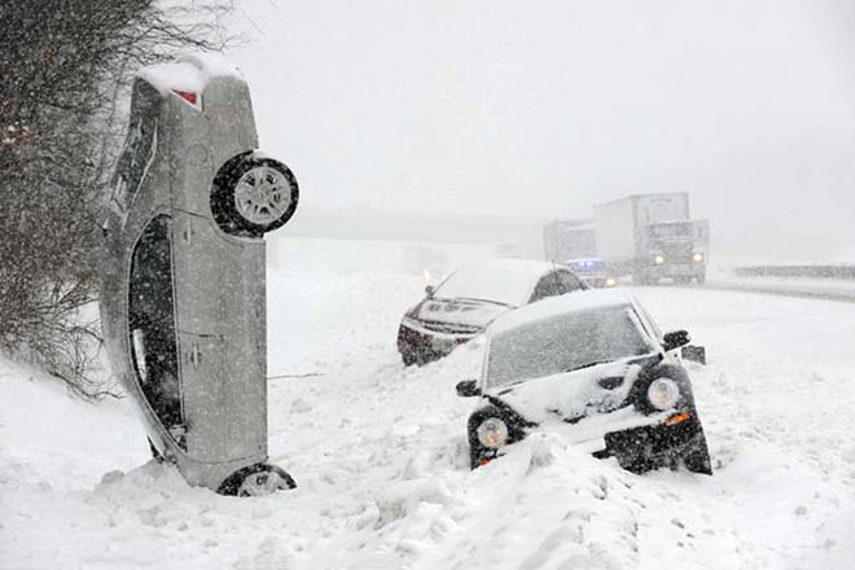Well, now you’ve gone and done it: you’ve mucked things up badly, screwed up hard, and picked a whole bouquet of oopsie-daisies. You’ve become stuck, badly, in some snow and ice and slush.
Probably, you’re already late for work or a meeting or a date. Maybe, you’re not dressed for the occasion. Likely, you’re swearing.
We care about you, and we want your winter to suck a little less. So, below, we’ve compiled some helpful tips to keep in mind this winter if you happen to find yourself stuck. Read on for the sticky.
Prepare Yourself
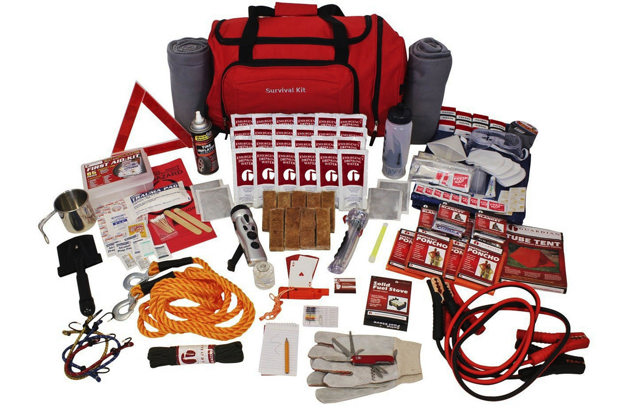
Proper preparation prevents pretty poor performance, and that’s why we’ll kick this list off with the following: if you get stuck in the snow, then it’s wintertime, which means you should have warm clothing, gloves and boots, and a working cellular phone accessible in your ride, at all times.
After all, if you insert your Rondo into a snowbank from which it cannot be easily freed, you’ll do a better job of releasing it if you’re properly dressed and not wet, freezing, and uncomfortable.
Also, winter tires. You should have these on your ride. Among many benefits, winter tires make it less likely that you’ll get stuck, and may make it easier to get moving again if you do.
Keep Gritty Stuff, and a Shovel, in your Vehicle
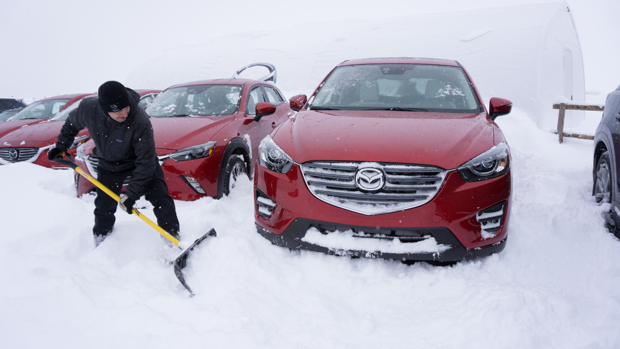
Don’t underestimate the ease with which a few simple supplies can help you free a stuck vehicle. As a bare minimum, keep a collapsible shovel and a few bags of kitty litter, traction salt, or sand, in your ride. Sometimes, a little shoveling and a little sand can make a world of difference.
Further, a set of tow straps can make life easier if a friend or passerby can help by yanking your ride from its icy prison. A reflective safety vest and flashlight are great to keep in your winter safety kit as well.
Consider Trac-Grabber Straps

I’ve tested the Trac-Grabber straps extensively, concluding that they might be the next best thing to calling a tow truck. When needed, you strap these grooved rubber blocks onto your drive wheels, gently apply the throttle, and let them bite into the slippery surface beneath, as they clear away snow from under the tires, and typically get you free, lickety-split. Just be sure you’ve got the right-sized set of straps for your ride, and that they’ll be usable on the type of wheels your ride rolls on. The straps can be stored in your trunk in a small pouch, install in minutes, and dramatically boost traction.
Here’s some more information on the Trac-Grabber straps.
Help Yourself Out

Upon the realization that you’re stuck, a few steps should be taken initially.
First, ensure the front wheels are pointed straight, since it’s harder to push or pull or move a stuck car when the wheels are turned. Straightening the wheels can improve your odds of getting moving again without calling a tow truck.
Some vehicles with all wheel drive or 4x4 have additional provisions to improve traction, including a “AWD Lock” or “4x4 Lock” function that, if present, is likely accessible via an obvious switch or dial in the cabin. Engaging any available “Lock” mode improves the vehicle’s ability to use any available grip, thereby improving your chances of freeing it.
Though obvious to some, be certain that your 4x4 truck or SUV has its 4x4 system engaged, for maximum traction. Sometimes, if you get stuck in a 4x4 that’s running in two-wheel drive, simply engaging four-wheel drive will be enough to get you moving.
Are You Hung Up?
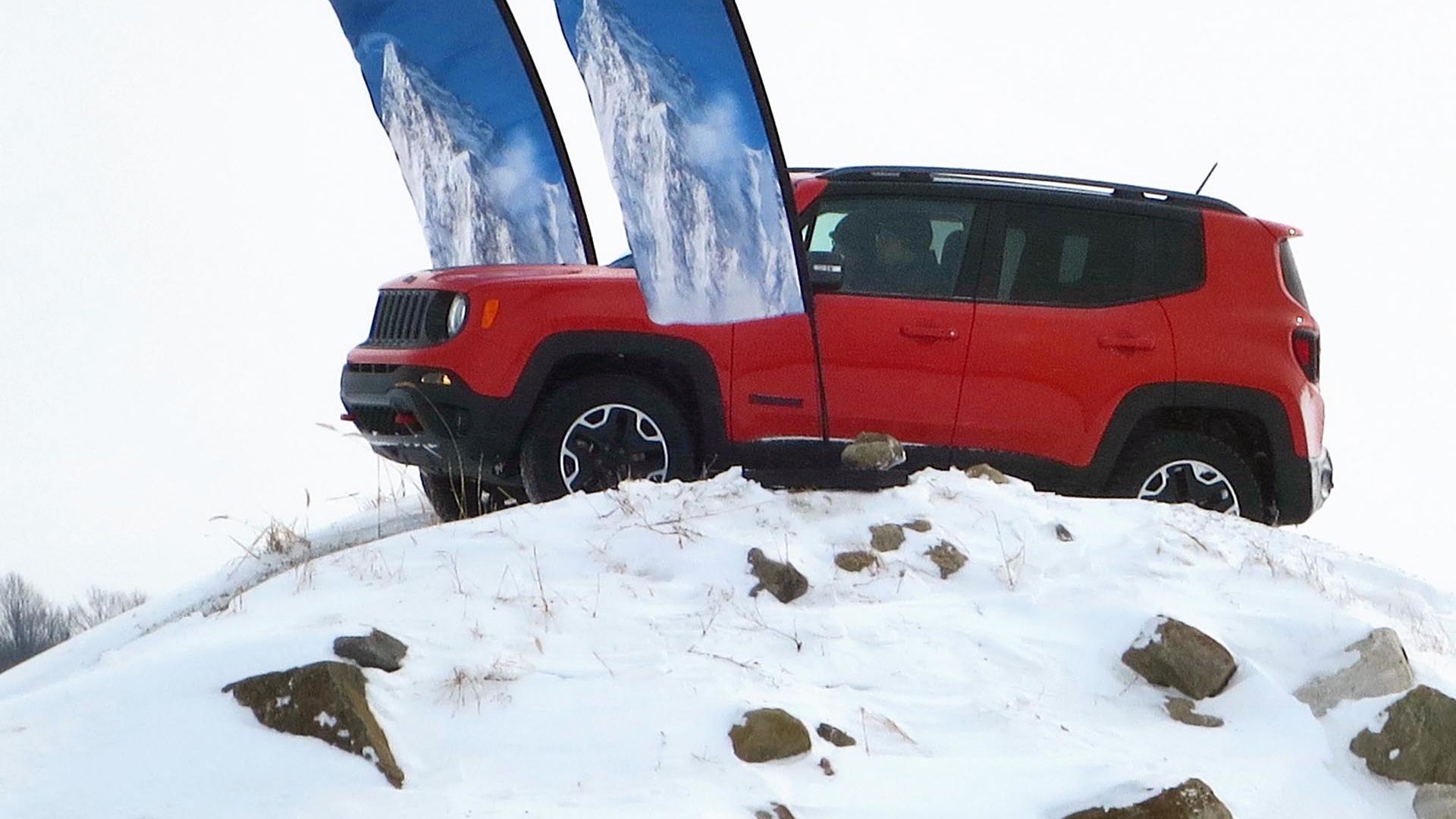
When outside of your ride assessing the present degree of stuck-ness, look underneath it. Can you see the underside of the vehicle, or is that resting on snow? If it is, chances are your ride is hung up, which means that most of its weight is resting on the snow beneath, and not the tires. You’ll need to dig beneath the vehicle to clear the snow out of the way, which allows more of your ride’s weight to rest on its tires, helping them grip. Attempting to free a vehicle that’s hung up can be a frustrating waste of time, so be absolutely sure to clear as much snow as physically possible from beneath, first.
Dig, Sprinkle, Repeat
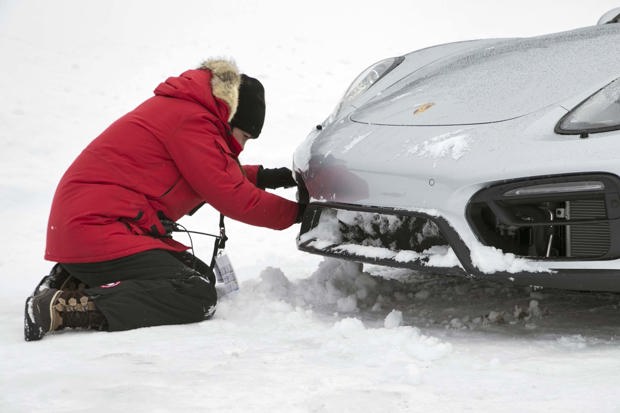
Shovel snow away from the wheels, clearing a path ahead (or behind) each. Clear as much snow as you can away from where your ride’s wheels need to go.
Next, apply salt and/or sand, vigorously, in the area in front of the drive wheels. Where possible, shove some sand and salt directly under the tire, right where it meets the ground – and leave a long, thin trail of gritty sand or salt in front of each drive wheel. This will help give your tires something to bite into as you try to free your ride.
Avoid Excessive Wheelspin
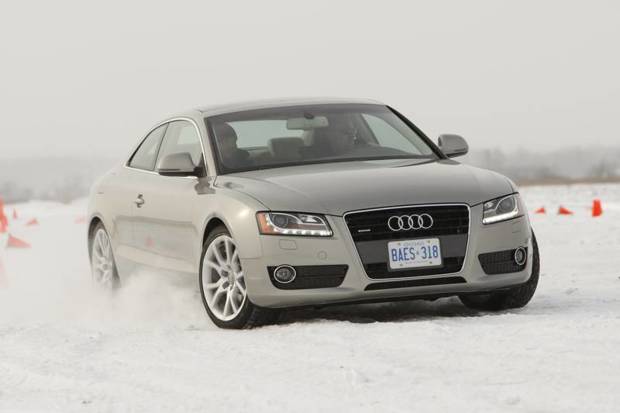
There’s a fine balance between too much and not enough wheelspin when you’re stuck, depending on a variety of factors. As a general rule, if your AWD vehicle is stuck, apply enough throttle to spin all four wheels at a low speed, but never for more than a few seconds at a time. Many AWD systems work best in challenging situations when there’s enough throttle applied to create a moderate amount of wheelspin.
If your vehicle is two-wheel drive, less wheelspin is typically better. Apply the throttle lightly at all times, and release it if the wheels spin more than a moment or two without any movement of the vehicle. Remember: wheelspin melts snow and slush, creating a layer of slippery water between your tires and the snow beneath. Wheelspin can also dig your vehicle tires even deeper into ruts.
The gist? A little continuous wheelspin is okay when trying to free a stuck vehicle with AWD, and a little less is ideal in a two-wheel drive. Never “floor” the accelerator, and never let the wheels free-spin for extended periods, or at a high rate of speed, since this almost always makes the situation worse.
If a bout of wheelspin creates some significant forward momentum, stay the course a moment longer, but release the throttle once the vehicle stops moving.
Rock It
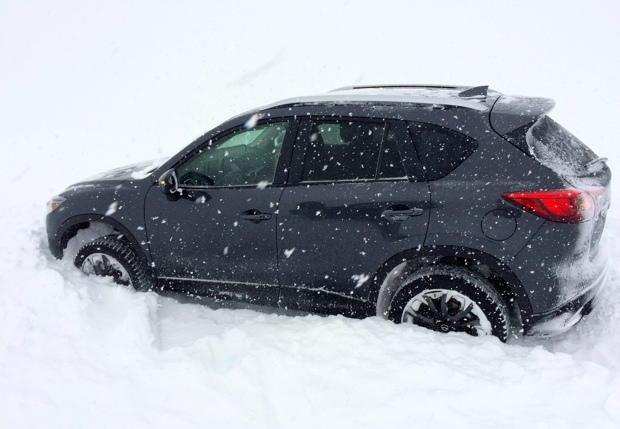
You can move forward a few inches, but that’s it. Best course of action? Stop the car, put it in Reverse, and back up that same amount. Then, engage Drive and try again. Maybe, you go forward another inch. Reverse again. Then, forward. Eventually, this back-and-forth rocking action may expand a little traction “runway” that can help you escape.
Just remember – be gentle with the throttle, keep wheespin to a minimum, be patient while working to rock your ride back and forth an inch or two at a time. Never switch gears while the wheels are moving, unless you’d like to be on a first-name basis with your local transmission shop.
Kill the Traction Control
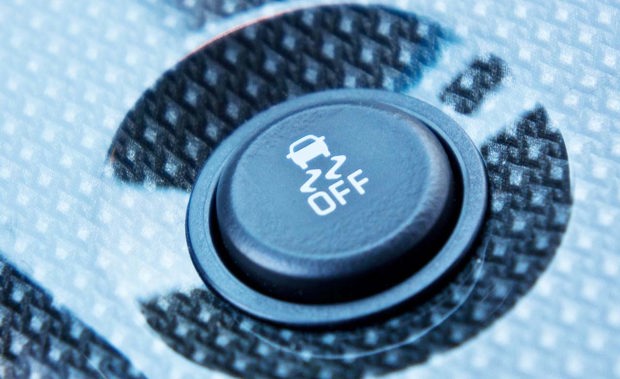
Note that while slowly spinning your wheels when stuck, a blinking light in the dash, accompanied by reduced throttle sensitivity and a clicking or crunching sound from beneath the vehicle, typically indicates that the traction control system is on, and functioning. You’ll want to turn it off – assuming you’re familiar with how your vehicle works, locate the traction control switch and shut the system down.
The traction control system can reduce your likelihood of freeing a stuck vehicle, sometimes dramatically, as it works to severely limit or even eliminate wheelspin, even in situations where a little wheelspin may be helpful. With the traction control off, apply the throttle as needed to create small amounts of brief, slow wheelspin as you try to free the vehicle.
Make the Area Near Your Vehicle Safer
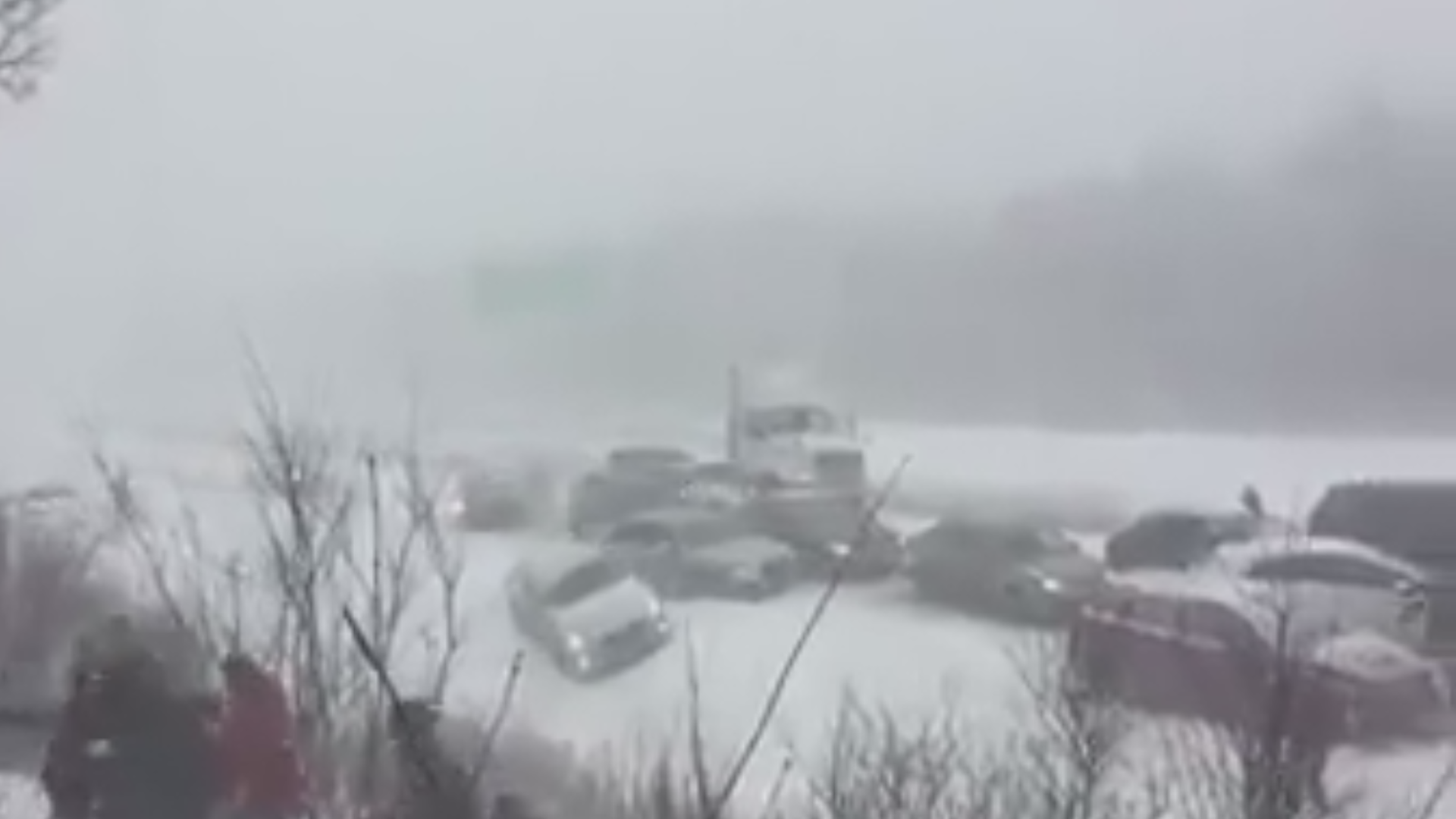
If you’re stuck on or near a roadway, be sure to engage all lighting, hazard lights, and to put up any safety flares or reflective provisions available, to keep the surrounding area safe. If you’re stuck dangerously close to a highway or busy road, or may be a hazard to other motorists, exit the vehicle when safe, and call for professional assistance. Do not enter a roadway to try and dig or push a stuck vehicle, as this is a major cause of injuries.
If you’re stuck for the long haul in deep snow, and need to run your engine, be absolutely sure to clear snow and ice away from the tailpipe(s), to prevent exhaust and poisonous gasses from being drawn back into your ride.
